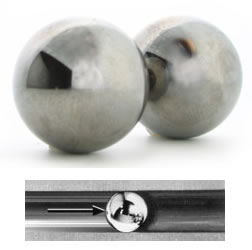
Tooling balls are commonly used in machining operations. Consisting of a heavy-duty metal construction — typically tungsten carbide — they provide a fixed reference point. To learn more about tooling balls and what they are used for, keep reading.
Positioning
One of the most common applications for which tooling balls are used is positioning. The tooling or “checking” ball is pulled into a hole. You can then use the tooling ball as a reference point.
There are shoulder-type and non-shoulder-type tooling balls available. Shoulder-type tooling balls feature a height reference shoulder, which you can use to identify their location. Non-shoulder-type tooling balls, as you may have guessed, do not have a high reference shoulder. Regardless, they are both in positioning applications for machinery.
Alignment
Tooling balls are used for alignment. Machines often feature parts that require aligning. To align two or more parts, you may need a reference point.
With a tooling ball, you’ll have the reference point necessary to align the parts. The tooling ball will provide you with a fixed reference point, which you can then use to use to adjustment and align the respective parts. Tooling balls excel in positioning and alignment applications.
Inspections
In some industries, such as the aerospace and automotive manufacturing industries, tooling balls are used for inspections. They provide a reference point. Manufacturers can use this reference point to verify the accuracy of their machines and ensure compliance with quality control and safety standards.
Ballizing
Whether shoulder-type or non-shoulder-type, most tooling balls consist of a metal ball connected to a stem. There are some balls, however, that only consist of a metal ball. Plain tungsten carbide balls such as these are commonly used in ballizing applications.
Ballizing is a material deformation process that involves the enlargement of a hole using a metal ball. A tungsten carbide ball can be forced through an existing hole to make it larger. As long as the tungsten carbide ball is slightly larger than the hole, it will enlarge it. A process known as ballizing, it’s a fast and consistent way to create holes in objects and materials.
Tungsten carbide balls are hard. This allows them to bore out holes, resulting in a larger hole diameter. With ballizing, a tungsten carbide is forced through a hole. The tungsten carbide ball will push out material while leaving behind a slightly larger hole.
In Conclusion
Tooling balls support a variety of applications. They are used for positioning, alignment and inspections. There are also plain tungsten balls that are used for ballizing.
